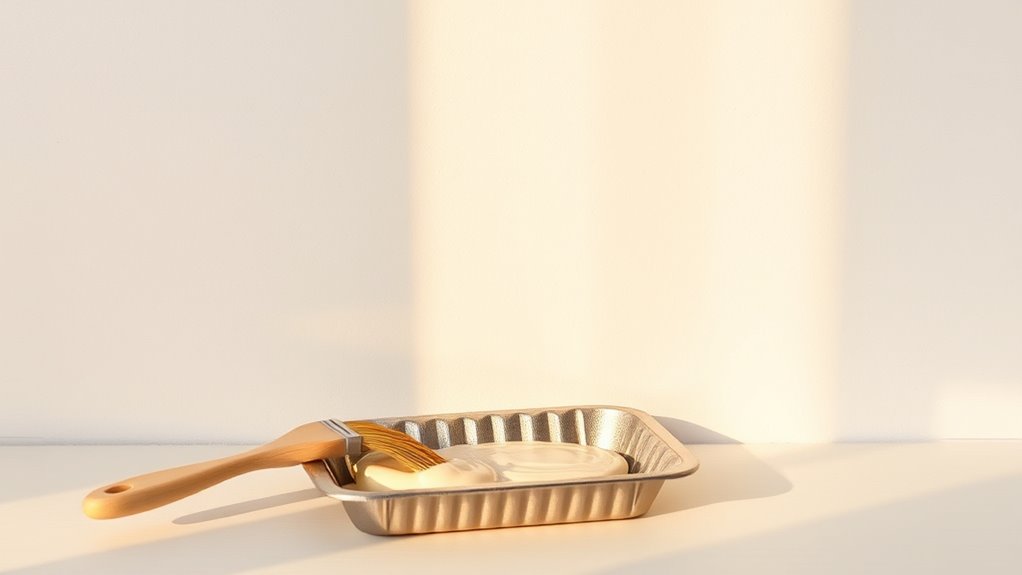
If you’re tackling a painting project, you might want to contemplate stain blocker primer paint. It’s designed to prevent stains from seeping through to your final coat, ensuring a clean and professional look. But not all primers are created equal. Understanding how to choose the right one can make a significant difference in your results. Let’s explore the benefits and types of stains that can be effectively treated.
Key Takeaways
- Stain blocker primer paint prevents stains from bleeding through, providing a protective barrier against water, smoke, and grease damage.
- It enhances paint adhesion on porous surfaces, ensuring a seamless and durable finish for your projects.
- Proper application involves cleaning, sanding, and repairing surfaces before applying thin, even coats of primer.
- Choosing a high-quality primer is essential for effective stain coverage and long-lasting results.
- Allow adequate drying time between coats and inspect surfaces for imperfections before proceeding with paint.
What Is Stain Blocker Primer Paint?
When you’re looking to achieve a flawless finish on your walls, stain blocker primer paint becomes an essential tool. This specialized primer helps prevent various stain types, like water stains, smoke damage, and even grease marks, from bleeding through your final coat of paint. The unique primer ingredients, such as shellac or alkyd, create a strong barrier that seals porous surfaces and guarantees your topcoat adheres properly. By using stain blocker primer, you’re not just covering imperfections; you’re also enhancing the longevity of your paint job. Whether you’re repainting a room or tackling a new project, this primer is your go-to solution for achieving that seamless look while protecting your walls from unsightly stains.
Benefits of Using Stain Blocker Primer Paint
Using stain blocker primer paint offers several key advantages that can enhance your painting project. It effectively prevents stains from bleeding through, guarantees better paint adhesion, and seals any surface imperfections. By choosing this primer, you set yourself up for a smoother, more durable finish.
Prevents Stains Effectively
A reliable stain blocker primer paint acts as a protective shield for your walls, effectively preventing unsightly stains from seeping through. Whether you’re dealing with water stains, grease, or smoke damage, this primer tackles various stain types with ease. Its unique formulation creates a barrier that stops stains in their tracks, ensuring your topcoat remains flawless.
You’ll appreciate the primer durability; it’s designed to withstand wear and tear, making it a smart investment for long-lasting protection. Applying this primer not only keeps your surfaces looking fresh but also minimizes the need for frequent repainting. By choosing a high-quality stain blocker primer, you’re safeguarding your home against potential damage and enhancing its overall appearance.
Enhances Paint Adhesion
Applying stain blocker primer paint not only prevents stains but also greatly enhances paint adhesion. When you use this primer, you’re ensuring better surface bonding, which leads to a longer-lasting finish. The adhesion benefits are significant; by creating a solid foundation, your topcoat will adhere better, reducing the chances of peeling or flaking.
| Adhesion Benefits | Surface Bonding |
|---|---|
| Stronger paint adherence | Reduces peeling risk |
| Improved durability | Even finish application |
| Enhanced color retention | Longer-lasting results |
Seals Surface Imperfections
When you want a flawless finish, stain blocker primer paint plays an essential role in sealing surface imperfections. It’s designed to fill in dents, scratches, and uneven textures, ensuring that your topcoat goes on smoothly. By using effective sealing techniques, this primer creates a uniform base that enhances the overall appearance of your paint job. You’ll notice that it not only hides flaws but also prevents them from showing through the final layer. This means you can achieve a professional look without spending extra time on repairs. In short, applying stain blocker primer paint saves you time and effort while delivering stunning results that you’ll love every time you walk into the room.
Types of Stains That Can Be Treated
Many homeowners encounter a variety of stains that can mar their walls, but not all stains are created equal. Water stains, often resulting from leaks or humidity, can create unsightly spots that need urgent attention. These stains can spread if not treated, leading to further damage. Smoke damage, on the other hand, can leave dark, persistent marks due to cooking or fire incidents. It’s essential to address these stains promptly to maintain your home’s aesthetic and prevent long-term issues. Stain blocker primer paint is effective in sealing and covering these types of stains, ensuring your walls look fresh and clean. Knowing which stains you’re dealing with helps you choose the right products for a successful treatment.
How to Apply Stain Blocker Primer Paint
Before you start applying stain blocker primer paint, you need to prepare the surface properly. This guarantees that the primer adheres well and effectively blocks any stains. Let’s explore the essential preparation steps and application techniques you’ll need to achieve the best results.
Surface Preparation Steps
Proper surface preparation is essential for achieving the best results when applying stain blocker primer paint. Follow these steps to guarantee your surface is ready:
- Surface Cleaning: Start by cleaning the area thoroughly. Remove dirt, grease, and any loose paint.
- Sanding: Lightly sand the surface to create a smooth texture. This helps the primer adhere better.
- Repairing: Fill any cracks or holes with appropriate filler. Allow it to dry completely before proceeding.
- Primer Selection: Choose a high-quality stain blocker primer tailored for your specific surface type.
Application Techniques Explained
Once you’ve prepared your surface, applying stain blocker primer paint requires careful technique to guarantee a smooth, even finish. You’ll want to choose the right application method based on your chosen primer types. For larger areas, a roller can help speed up the process, while a brush is ideal for corners and edges.
| Application Method | Best Use |
|---|---|
| Roller | Large Areas |
| Brush | Edges & Corners |
| Spray | Quick Coverage |
| Pad | Textured Surfaces |
Make certain to apply in thin, even coats, allowing each layer to dry completely before adding another. This guarantees the best stain blocking and a flawless final appearance.
Choosing the Right Stain Blocker Primer for Your Project
How do you know which stain blocker primer is best for your project? Start by considering a few key factors. Avoid common application mistakes by evaluating the conditions and surfaces you’ll be working with. Here’s a quick checklist to guide your primer comparisons:
- Surface Type: Identify if you’re priming wood, drywall, or metal.
- Stain Severity: Assess the extent of the stains you need to cover.
- Finish Type: Decide if you want a flat, satin, or gloss finish after priming.
- Drying Time: Check how quickly the primer dries to plan your project timeline.
Tips for Achieving a Flawless Finish
Achieving a flawless finish requires attention to detail and a few essential techniques. First, always perform a primer comparison to select the best product for your surface. Avoid common application mistakes by following these tips:
| Tip | Description |
|---|---|
| Surface Preparation | Clean and sand surfaces thoroughly |
| Right Tools | Use high-quality brushes or rollers |
| Even Coats | Apply thin, even coats of primer |
| Drying Time | Allow adequate drying time between coats |
| Inspect Before Paint | Check for imperfections before painting |




